
Macrozamia is a genus of around forty species of cycads, family Zamiaceae, all of which are endemic to Australia. Many parts of the plant have been utilised for food and material, most of which is toxic if not processed correctly.
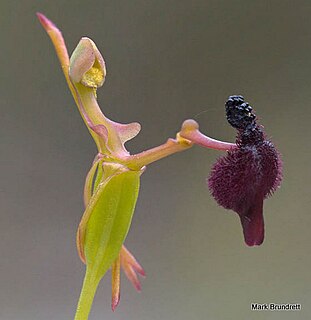
Drakaea is a genus of 10 species in the plant family Orchidaceae commonly known as hammer orchids. All ten species only occur in the south-west of Western Australia. Hammer orchids are characterised by an insectoid labellum that is attached to a narrow, hinged stem, which holds it aloft. The stem can only hinge backwards, where the broadly winged column carries the pollen and stigma. Each species of hammer orchid is pollinated by a specific species of thynnid wasp. Thynnid wasps are unusual in that the female is flightless and mating occurs when the male carries a female away to a source of food. The labellum of the orchid resembles a female thynnid wasp in shape, colour and scent. Insect pollination involving sexual attraction is common in orchids but the interaction between the male thynnid wasp and the hammer orchid is unique in that it involves the insect trying to fly away with a part of the flower.
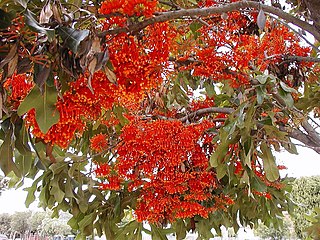
Stenocarpus is a genus of about 25 species of woody trees or shrubs, constituting part of the plant family Proteaceae.
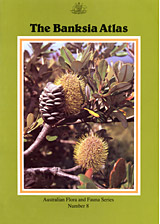
The Banksia Atlas is an atlas that documents the ranges, habitats and growth forms of various species and other subgeneric taxa of Banksia, an iconic Australian wildflower genus. First published in 1988, it was the result of a three-year nationwide program involving over 400 amateur and professional volunteers.

Banksia gardneri, commonly known as prostrate banksia, is a species of prostrate shrub that is endemic to Western Australia. It has pinnatipartite or serrated leaves, usually rusty brown flowers, and up to twenty-five elliptical follicles in each fruiting head. It occurs along the west part of the south coast of the state.

Banksia occidentalis, commonly known as the red swamp banksia, is a species of shrub or small tree that is endemic to the south coast of Western Australia. It has smooth bark, linear, sparsely serrated leaves, golden flowers in a cylindrical spike, and later up to sixty follicles in each spike.
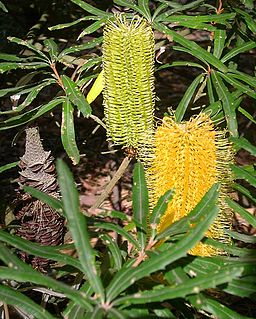
Banksia seminuda, commonly known as the river banksia, is a tree in the plant genus Banksia. It is found in south west Western Australia from Dwellingup (32°42′ S) to the Broke Inlet east of Denmark (34°57′ S). It is often mistaken for, and was originally considered a subspecies of, the Banksia littoralis. Stephen Hopper described the subspecies remanens as a short-leaved shrubby form found in the coastal sands below granite outcrops in the Walpole-Nornalup National Park, however George does not feel this form warrants taxonomic recognition as it lies within the normal variability of the species and there was no clear distinction between it and the other populations of B. seminuda.

Banksia tricuspis, commonly known as Lesueur banksia or pine banksia, is a plant in the family Proteaceae and is endemic to a small area in the south-west of Western Australia. It is a stunted tree or shrub with narrow leaves and cylindrical spikes of golden-coloured flowers and it occurs in a geographic range of just 15 square kilometres near Jurien.
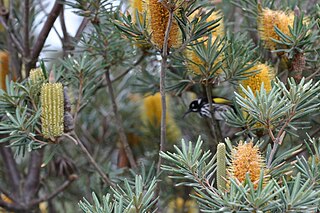
Banksia verticillata, commonly known as granite banksia or Albany banksia, is a species of shrub or (rarely) tree of the genus Banksia in the family Proteaceae. It is native to the southwest of Western Australia and can reach up to 3 m (10 ft) in height. It can grow taller to 5 m (16 ft) in sheltered areas, and much smaller in more exposed areas. This species has elliptic green leaves and large, bright golden yellow inflorescences or flower spikes, appearing in summer and autumn. The New Holland honeyeater is the most prominent pollinator, although several other species of honeyeater, as well as bees, visit the flower spikes.
Banksia viscida, commonly known as sticky dryandra, is a small shrub known only from four laterite hills in semi-arid inland Western Australia. Known until recently as Dryandra viscida, it is thought to be rare but not threatened.

Parsonsia is a genus of woody vines in the family Apocynaceae. Species occur throughout Indomalaya, Australasia and Melanesia.
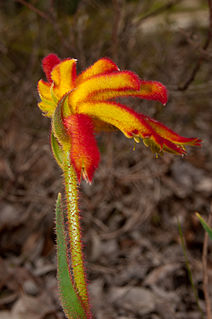
Anigozanthos humilis is a species of Anigozanthos in the family Haemodoraceae. This flowering perennial plant is endemic to Southwest Australia and widespread in its open forests. Common names include Catspaw and Common Cat's Paw.

The flora of Western Australia comprises 10,252 published native vascular plant species and a further 1,245 unpublished species. They occur within 1,543 genera from 211 families; there are also 1,276 naturalised alien or invasive plant species more commonly known as weeds. There are an estimated 150,000 cryptogam species or nonvascular plants which include lichens, and fungi although only 1,786 species have been published, with 948 algae and 672 lichen the majority.

Stypandra glauca is a species of rhizomatous perennial plant. It is widespread across southern areas of Australia, where it is informally known as the nodding blue lily or blind grass.

Thelionema is a small genus of tufted perennials in the family Asphodelaceae, subfamily Hemerocallidoideae. All three species, which were previously placed in the genus Stypandra, are native to Australia. These are:

Thelionema caespitosum, the tufted lily or tufted blue-lily, is a species of perennial herb, native to Australia. The lily-like flowers are blue, light blue, pale yellow or white and have yellow stamens.
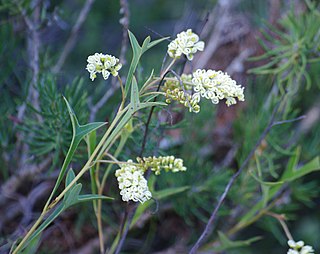
Grevillea synapheae, the catkin grevillea, is a shrub in the family Proteaceae. It is endemic to the southwest of Western Australia, occurring in low heathland.

Cenarrhenes is a monytypic genus in the family Proteaceae containing the single species Cenarrhenes nitida, known as the Port Arthur plum or native plum. Cenarrhenes nitida is an evergreen shrub to small tree endemic to the rainforests and scrublands of western Tasmania. It bears white flowers in late spring followed by the development of fleshy fruit.

Conostylis albescens is a rhizomatous, tufted perennial plant species in the family Haemodoraceae, endemic to the south-west of Western Australia. Plants grow to between 12 and 17 cm high and produce yellow-cream-white flowers in August in the species' native range. The grey-green, hairy, leaves are 12–17 cm long and 0.8–1.5 mm wide.

Conostylis argentea is a rhizomatous, tufted perennial plant species in the family Haemodoraceae, endemic to the south-west of Western Australia. In July and August it produces white to cream flowers in the species' native range.



















